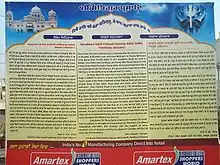Nada Sahib
Nada Sahib is a Sikh Gurudwara in the Panchkula district of the Indian state of Haryana. Situated on the banks of the Ghaggar-Hakra River in the Sivalik Hills, Panchkula, it is the site where Guru Gobind Singh Ji halted while travelling from Paonta Sahib to Anandpur Sahib after the Battle of Bhangani in 1688.

Architecture
The original Manji Sahib was replaced by a two-story domed structure, with an adjacent large rectangular meeting hall. A spacious brick courtyard separates these buildings from the complex comprising the Guru ka Langar and rooms for pilgrims. The holy flag flies atop a 105 feet (32 m) high staff on one side of the courtyard, near the site of the old shrine. Religious gatherings and community meals take place daily. Every full moon day is celebrated, attended by large crowds.[1]
A museum covering Sikh history is hosted at Nada Sahib.[2]
History

The place remained obscure until nearby villager Bhai Motha Singh discovered the sacred spot and raised a platform to memorialize the Guru's visit. Nothing more is known of the devout Motha Singh nor of the date of the establishment of the Manji Sahib, except that the shrine was under the Dharmarth Board of Patiala and East Punjab States Union in 1948 and was taken over by the Shiromani Gurdwara Parbandhak Committee (SGPC) after the merger of the state with Punjab in 1956.
At the Battle of Bhangani, Guru Gobind Singh initially did not do well, but ultimately won the battle. The Bachitar Natak mentions that the battle resulted in the victory of the Guru's forces and the enemy forces fled from the battlefield.
The Guru, though victorious, did not occupy the conquered territory. Some historians such as H. Raturi, Anil Chandra Banerjee and A. S. Rawat speculate that the battle must have ended without conclusive result, since the Guru's victory is not reflected in any territorial annexations. The Guru entered into an understanding with Bhim Chand soon after the battle. However, this was most likely because the Guru was not after territorial gains, behaving as his great grandfather Guru Hargobind had done when winning battles against the Mughals.
References
- G.S., Randhir (1990). Sikh shrines in India. New Delhi: The Director of Publication Division, Ministry of Information and Broadcasting, Government of India. pp. 13–14.
- "Museum at Nadda Sahib to showcase Sikh history - The Times of India". Indiatimes. Retrieved 12 March 2011.